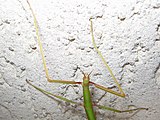|
Bacillus rossius
The European stick insect (Bacillus rossius) also called the European stick bug, European walking stick, or Mediterranean stick insect, is a species of stick insect, common in southern Europe. The species is endemic to the northwestern Mediterranean, especially Italy, Spain, Southern France, and the Balkans.[2][3] OverviewAdults have a slim body, with short antennae and long, thin legs. Colors vary from brown to green, sometimes with a pinkish tinge on its head, legs and sides. This species can eat bramble leaves, ivy, and privet. B. rossius can be found from June to mid December and the eggs look like seeds. Females are larger than the male, with a bigger abdomen. An adult can be 10 cm (4 inches) in length. Life cycleThe nymphs hatch out from their seed-like eggs 8 weeks to 2 months after being laid by a female. like the adult, the nymphs sway as in a breeze to avoid predators. B. rossius lives up to a year. They are nocturnal and may stay still for hours and usually feed at night. They shed the exoskeleton a few times in their life. PredatorsThe predators include birds, frogs, lizards, rodents and spiders. Gallery
See also
References
External links
|
||||||||||||||||||||||||||||||||||||
Portal di Ensiklopedia Dunia







